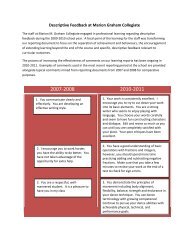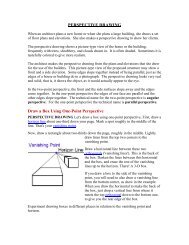Double Ball (We Pitisowewepahikan) - Saskatoon Public Schools
Double Ball (We Pitisowewepahikan) - Saskatoon Public Schools
Double Ball (We Pitisowewepahikan) - Saskatoon Public Schools
You also want an ePaper? Increase the reach of your titles
YUMPU automatically turns print PDFs into web optimized ePapers that Google loves.
http://schools.spsd.sk.ca/brightwater/<br />
Brightwater Site<br />
<strong>Double</strong> <strong>Ball</strong> (<strong>We</strong> <strong>Pitisowewepahikan</strong>)<br />
Origin: The Plains tribes and tribes throughout Eastern United States played <strong>Double</strong><br />
<strong>Ball</strong> or a variation of this game.<br />
Motivational Set: Start with a „Greeting Circle‟. Have students sit in a circle. Begin<br />
by initiating the following greeting to the person on your left, “Tansi, Namoyaw”<br />
(tanse, nĕ moi ĕ)-“Hello, how are you?” The person on your left responds with<br />
“Nanitow” (nĕmĕnto)- “Fine thank-you.” In turn, the person on your left turns to the<br />
person on their left and repeats, “Tansi, Namoyaw.” This format continues until the<br />
circle is complete.<br />
Once the circle is complete, tell students we will be learning how to play the game<br />
“<strong>Double</strong> <strong>Ball</strong>” which is called <strong>Pitisowewepahikan</strong> (way - pee/tĕ/sō/way - way pă/hē<br />
gŭn) in Cree. Have them repeat the Cree name several times with you.<br />
History: In most regions, <strong>Double</strong> <strong>Ball</strong> was played exclusively by women but over<br />
time has become a game played by both genders. <strong>Double</strong> <strong>Ball</strong> is sometimes<br />
referred to as “The Woman‟s <strong>Ball</strong> Game”. It is a physically active game that requires<br />
skill and endurance.<br />
The implements used for this game include two balls attached with a thong and 3<br />
meter long curved sticks. The balls and sticks used vary from location to location<br />
depending on the environment of the tribe. Many tribes played similar games with<br />
their own unique adaptations. This was most often dependent upon environmental<br />
conditions and what materials were readily available. For example, the Plains Cree<br />
used a stick approximately three feet long and a double ball made from two sacks of<br />
deerskin stuffed with buffalo hair, joined by a leather thong. (Show students the<br />
equipment-courtesy of <strong>Saskatoon</strong> <strong>Public</strong> Brightwater Camp). The Chippewa tribe in<br />
Wisconsin used a sharp stick that was slightly bent at the end and leather bags filled<br />
with sand, attached by a thong for the double balls.<br />
The playing surface used was the open prairie fields with the goals placed up to one<br />
kilometer apart. The object of the game was to be the first team to throw the ball<br />
over your opponent‟s goal line and between the markers.<br />
1 | P a g e
<strong>Saskatoon</strong> <strong>Public</strong> <strong>Schools</strong><br />
Games of chance and skill were shared with other tribes and thought of as gifts.<br />
<strong>Double</strong> <strong>Ball</strong> would be classified as a game of skill. During times of celebration and<br />
large gatherings, one tribe would challenge another to games. Today we honor<br />
traditional games through venues such as the North American Indigenous games.<br />
Number of Players: 8 or more (2 teams)<br />
Playing Space: A soccer field, football field, or an open field where the goals are at<br />
least 100 yards apart. (Can play in the gym using a modified version.)<br />
Equipment: 3 meter long, ¾” wide dowel sticks.<br />
Goal markers (pylons or posts)<br />
2 small balls or bean bags fastened together with a leather thong.<br />
*Consider safety goggles when using long handled implements.<br />
Instructions to Make:<br />
• Purchase and cut ¾” dowelling (Home Depot) into 3 meter long pieces.<br />
Sand each end and paint ½ of each stick one color. Repeat until half of<br />
the sticks are one color and the other half are another. For example, 4<br />
red and 4 blue. This visual helps the player to adjust the location of the<br />
<strong>Double</strong> <strong>Ball</strong> on the stick before throwing and to be able to differentiate<br />
who is on your team.<br />
• Purchase deer hide (Textile and Sewing Supplies). Stuff and sew sacs<br />
using heavy weight thread and beanbag pellets or other suitable<br />
material. The material should be pliable and have a slight weight to it<br />
(comparable to that of a bean bag)<br />
Object of the Game: The object of the game is to be the first team to successfully<br />
throw the <strong>Double</strong> <strong>Ball</strong> over the opponent‟s baseline between their goal markers.<br />
(Modify by playing best of 3 or 5)<br />
Psychomotor Objective: The students will be able to demonstrate an<br />
understanding of the mechanics of catching and throwing using the proper<br />
technique with a long handled implement while moving in both personal and<br />
general space in addition to gaining physical strength and endurance from the<br />
cardiovascular workout it provides.<br />
Cognitive Objective: The students will be able to explain and/or demonstrate the<br />
proper technique when using long handled implements and apply this knowledge in<br />
a game situation.<br />
Affective Objective: The students will be able to foster their emotional need for<br />
social belonging by experiencing teamwork, cooperation, and practicing good<br />
sportsmanship while playing the game.<br />
2
<strong>Saskatoon</strong> <strong>Public</strong> <strong>Schools</strong><br />
Spiritual Objective: The students will be able to apply the history they learned<br />
from this traditional game to games of the present. Students will be able to make the<br />
connection between the origin of the materials and the environment. (eg. buffalo,<br />
trees)<br />
Required Skills:<br />
Throwing (Sending) with Long Handled Implements:<br />
• To begin, start with the underhand pass. First to a stationary partner, then to a<br />
moving partner. Teach proper form before concentrating on distance or<br />
accuracy. Once the mature form of the skill is developed, throwing for<br />
accuracy at a moving target in a game situation can be practiced.<br />
• Learning Cues for Underhand Pass<br />
o Face Partner (Your body should be facing your partner.)<br />
o Both hands on the stick on your throwing side. Both hands will be on<br />
the stick (dominant hand above the less dominate) with your dominant<br />
hand behind your seat.<br />
o Opposite leg from the throwing side is forward, facing the target.<br />
<strong>We</strong>ight is on the back foot.<br />
o Step towards target with the foot opposite throwing arm. <strong>We</strong>ight shifts<br />
to forward foot.<br />
o Rotate the hips as the throwing arm moves forward (hips now facing<br />
forward).<br />
o As hips are rotating, Flick your dominant wrist from behind while<br />
aiming at the target. The dominant hand should lead the forward<br />
movement of the arm.<br />
Beginner Cues: Step, Turn, Throw<br />
Tell students to throw as hard as possible (at the wall) since speed and accuracy are<br />
most important in this stage. Students can practice against a wall or in a large field<br />
for distance.<br />
Advanced Cues: Look, Side, Back, Step, Turn, Follow Through<br />
Once a mature throwing pattern is developed, aiming at a target or throwing to a<br />
partner can be introduced.<br />
• Learning Cues For Overhand Pass<br />
o Look (Find your target)<br />
o Side To Target (Make sure the side of your body away from the hand<br />
you are throwing with is toward the wall; if you were to walk straight<br />
ahead, you would walk along the wall, not towards it.)<br />
3
<strong>Saskatoon</strong> <strong>Public</strong> <strong>Schools</strong><br />
o Arm Back (bring your throwing arm back so that your less dominant<br />
elbow is almost at the level of your chin and your dominant hand is<br />
behind your head. Your elbow should be pointing at your target.<br />
o Step With Opposite Foot (Step forward on the foot opposite the side<br />
you are using to throw)<br />
o Turn (Rotate your upper body toward the direction of your target<br />
while your implement releases the ball at approximately eye level.)<br />
o Follow Through (After you throw, have your arm follow the ball. Your<br />
implement should end up at approximately knee level.)<br />
Catching (Receiving) with Long Handled Implements:<br />
• Learning Cues for Catching:<br />
o Watch the Object (Keep your eye on the ball)<br />
o Reach (Reach for the object with your implement. Pay attention to your<br />
grip. It should resemble that of a hockey stick grip)<br />
o Pull (Absorb the force of the ball by pulling back on the stick)<br />
How To Play:<br />
• Players are divided into two teams.<br />
• The game begins with one player throwing the ball toward center field.<br />
• The ball, once caught by a player, cannot be carried on the stick. It must be<br />
passed from one player to another. (Modifications can be made to<br />
incorporate a certain number of steps)<br />
• Players must try to move the ball up field with the goal of throwing it over the<br />
baseline and between the markers of the opponent‟s goal. The first team<br />
which does this wins.<br />
• Players can try to take possession of the ball by trying to knock it off their<br />
opponent‟s stick.<br />
• If a player drops the <strong>Double</strong> <strong>Ball</strong>, they lose possession to the opponent. A<br />
player cannot touch the <strong>Double</strong> <strong>Ball</strong> with their hands or feet.<br />
Adaptations for Younger Students<br />
• Decrease the distance of the playing field<br />
• Increase the size of the goal<br />
• Use underhand passes only<br />
• Do not allow the opponent to be able hook the ball off another player<br />
• Have two separate games going at the same time so there are more<br />
opportunities to practice sending and receiving the ball.<br />
• Student can be stationery to receive the ball<br />
Adaptations for Older Students:<br />
• Increase the area of the field.<br />
• Decrease the size of the goal<br />
4
<strong>Saskatoon</strong> <strong>Public</strong> <strong>Schools</strong><br />
• Use posts for the goal and have students have to „ring‟ the ball around the post<br />
in order to score a goal.<br />
• Increase the length of the game. For example, the first team who scores 3<br />
wins the round. Have a contest for the best out of 3 games.<br />
• Student must be moving to receive the ball<br />
• Each person on the team has to receive the ball before scoring<br />
• When practicing sending and receiving with a partner, have students vary the<br />
distance between them and their partner, vary the size of the target on the<br />
wall when practicing for accuracy, vary the levels of the targets, vary the force<br />
and speed of the throw, and have the thrower send the ball out of reach so the<br />
receiver has to move farther and farther away to make contact.<br />
Relevance to Curriculum:<br />
• To provide a specific example of how indigenous people have contributed to<br />
the development of sport of today.<br />
• To provide students with opportunities to nurture the four aspects of growth<br />
through sport (Physical, Emotional, Mental, and Spiritual)<br />
• By presenting students with the opportunity to participate in physical<br />
education by developing knowledge, skills, and attitudes necessary to<br />
become physically educated persons.<br />
• Students will apply basic movement patterns including sending, receiving,<br />
evading, accompanying, locomotion, landings, pathways, and rotations.<br />
• Students will expand on their movement variables. Body, space, effort, and<br />
relationships are all factored in when playing <strong>Double</strong> <strong>Ball</strong>.<br />
• Basic movement principles are learned. Stability and force are critical<br />
components when learning the skill of throwing and catching with a long<br />
handled implement.<br />
• Students become aware of the inclusion of ethnic diversity and the importance<br />
of Aboriginal content into the curriculum.<br />
5







